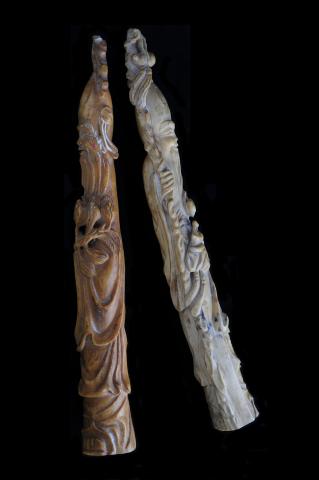Preventive Conservation
For conservation purposes ivory, bone, antler, horn, baleen and tortoise shell may be treated in the same manner, as they react in similar ways to given environments and treatments. For convenience, from this point all these materials will be referred to as ‘ivory’.
Although ivory artefacts are reasonably durable, as is evident from the age and condition of many prehistoric materials, they can be damaged readily if improperly cleaned, handled, stored or exhibited.
Environment
Because of the sensitivity of these materials to changes in relative humidity, keep them within a temperature range of 15 – 25 °C and a relative humidity range of 45 – 55 %, with no more than a 4 °C and/or a 5 % swing respectively within a 24-hour period. It is desirable to maintain an environment with a steady relative humidity and temperature and, most importantly, to prevent exposure to extreme conditions or rapid fluctuations.
Volumetric changes for ivory are at a minimum between 30 - 40 % but this is a risky low relative humidity for many objects. For example, a change in relative humidity from 40 % to 45 % causes a volumetric change of only about 0.35 % while a change from 60 % to 65 % causes a 1 % volume change. The effect of relative humidity changes on an object depends upon how it was cut from the tusk. Dimensional changes in the longitudinal direction are minimal and radial changes do not become apparent until above 50 %. Changes in the tangential changes are almost linear between 30 % and 100 % relative humidity, with an average increase of approximately 6 % (Turner-Walker, 2017).
As ivory materials are affected by moisture, avoid dramatic changes in relative humidity. Usually, materials from tropical regions will have a higher moisture content than similar materials from drier areas. For this reason, slow acclimatisation to a new environment is essential in order to reduce the possibility of cracking or splitting (see the chapter Preventive Conservation: Agents of Decay).
If stored in the dark, ivory appears to darken in colour. This is due to a natural and slow ageing process that leads to the development of a pale yellowish-brown patina. In the presence of light this ageing is counteracted by bleaching of the ivory surface. Ivory materials should never be placed in direct sunlight or bright artificial light however as fading of colourings and dyes or an overall bleaching of the surface will occur.
If ivory is dyed, do not allow light levels to exceed 50 lux with the UV component restricted to 30 µwatts/lumen (1500 µwatts/m2). For undyed material illumination levels should not exceed 200 lux with the UV component restricted to 75 µwatts/lumen (15000 µwatts/m2).
Handling
To prevent staining of the surface, wear cotton gloves when handling ivory materials, except for some archaeological ivories where raised splinters and cracks can catch on the knit of the cotton gloves.
When packing ivory for transportation ensure there is an adequate buffer against both physical damage and changes in temperature and relative humidity. Wrap artefacts in acid-free tissue, place in a sealed polyethylene bag, wrap with bubble wrap and then pack in an insulated box. The aim is to control the temperature and therefore the relative humidity within the sealed bag.
Storage and Display
Place ivory within a display case or cabinet as these provide protection from dust and dirt and also buffer changes in temperature and relative humidity. Due to the emission of acidic vapours from some timbers, metal cabinets are preferred to wooden ones.
Store ivory under low light and low UV levels (see Environment above). As light bleaches the surface of ivory considerable variation in colour may occur unless objects are moved in relation to the predominant light source (Figure 6). The effect of different exposures to light is usually evident in the differing colours produced on the front and back, or upper and lower, surfaces of objects. Ensure lighting has no effect on the internal temperature and hence the relative humidity of display cases used to house ivory artefacts (see the chapter Preventive Conservation: Agents of Decay).
Figure 6: Chinese sage carved from a juvenile elephant's tusk showing the effects of light causing differential colouration. One side was continually exposed to the sun over a 10 year period, leading to yellowing, drying and eventual irreversible splitting (copyright: Gordon Turner-Walker).
Additional storage and display considerations include the following:
- use inert materials, such as spun polyethylene or polypropylene to line storage shelves to provide cushioning;
- do not use rubber pads or adhesives near ivory as the sulphur in these materials will discolour ivory;
- avoid contact with iron, copper alloys and coloured materials as staining may result; and
- inspect horn regularly as it is the material most likely to suffer from insect attack.

